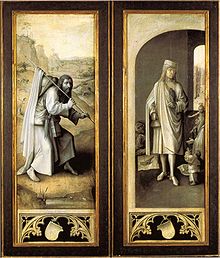Last Judgment triptych

|
| Last Judgment triptych |
|---|
| Hieronymus Bosch , 1485 to 1505 |
| Oil on oak |
| Picture gallery of the Academy of Fine Arts Vienna , Vienna |
The Weltgerichtstriptychon or Weltuntergangs triptych ( Laatste oordeel ) is a painting by Hieronymus Bosch . The triptych is exhibited in the Academy of Fine Arts in Vienna .
description
- Dimensions
- Central panel: 163.7 × 127 cm
- left side panel: 167.7 × 60 cm
- right side panel: 167 × 60 cm
- material
- Oil on oak panels
- Dating
- The picture is not signed and not personally dated; It is believed to have originated between 1485 and 1505.
- Status
Due to several restorations in the past, the painting is in a poor state of preservation.
content
The themes of the triptych are Paradise , Last Judgment and Hell . The left panel begins with the creation of Eve, the fall of man, the expulsion of Adam and Eve from paradise and the fall of the fallen angels into hell . The central panel shows the sinful goings-on of the people, above it a gloomy doomsday scenario with smoking ruins and without sunlight and finally Christ as the judge of the world on the rainbow with the angels of the Apocalypse , the twelve apostles, Mary and John the Baptist and surrounded by the choirs of angels . Finally, the third panel shows those condemned by the judge of the world and the horrors of hell.
The outside panels of the triptych, painted in grisaille , show St. James as a pilgrim with a clam hat , pilgrim staff and begging sack and St. Bavo , a saint venerated in Flanders, distributing gifts to the poor.
Provenance
The oldest documented mention of the picture comes from an inventory of the collection of Archduke Leopold Wilhelm of Austria from 1659, it is listed as a work by the hand of "Hieronimo Bosz". At the end of the 18th century it came into the possession of Count Lamberg-Sprinzenstein (1740–1822), who donated the picture with his entire art collection to the Academy of Fine Arts in Vienna in his will.
Art historical classification
Bosch follows the tradition of Rogier van der Weyden and Hans Memling . Their Last Judgment triptychs serve as altarpieces. At Bosch, most people are not saved, but tortured by devils; only a few are carried to heavenly paradise by angels. In the overall picture of the triptych, the rescued are almost only a marginal phenomenon, while in Rogier and Memling the rescued and the damned are in balance.
The fantastic figures make up the charm of the pictures. In addition to the mythical creatures with animal heads and human bodies, human figures are also represented in a special way in the Last Judgment. In the lower left of the middle panel there is a man who consists only of head and feet and wears a headscarf and colorful pheasant feathers. In the lower center there is a similar head-footed fish that is stuck in an egg. The third head-footer crouches on the roof to the left of the human mill. In addition to the demonic torturers, the angels, the damned and the saints, the head-footers may form another group that did not yet exist in the Last Judgment pictures before Bosch.
literature
- Larry Silver: Hieronymus Bosch , Munich 2006, pp. 337–347.
- Renate Trnek, Heribert Hutter : The Last Judgment Triptych by Hieronymus Bosch . Vienna 1988. ISBN 3218004829
- Renate Trnek: The Last Judgment Triptych by Hieronymus Bosch . Picture gallery of the Academy of Fine Arts Vienna. Vernissage masterpieces. Heidelberg 2003.
- Max J. Friedländer : Early Netherlandish Painting. Volume V. Geertgen tot Sint Jans and Jerome Bosch . Leiden 1969.
Web links
Individual evidence
- ↑ www.aeiou.at Entry in Austria Forum.
